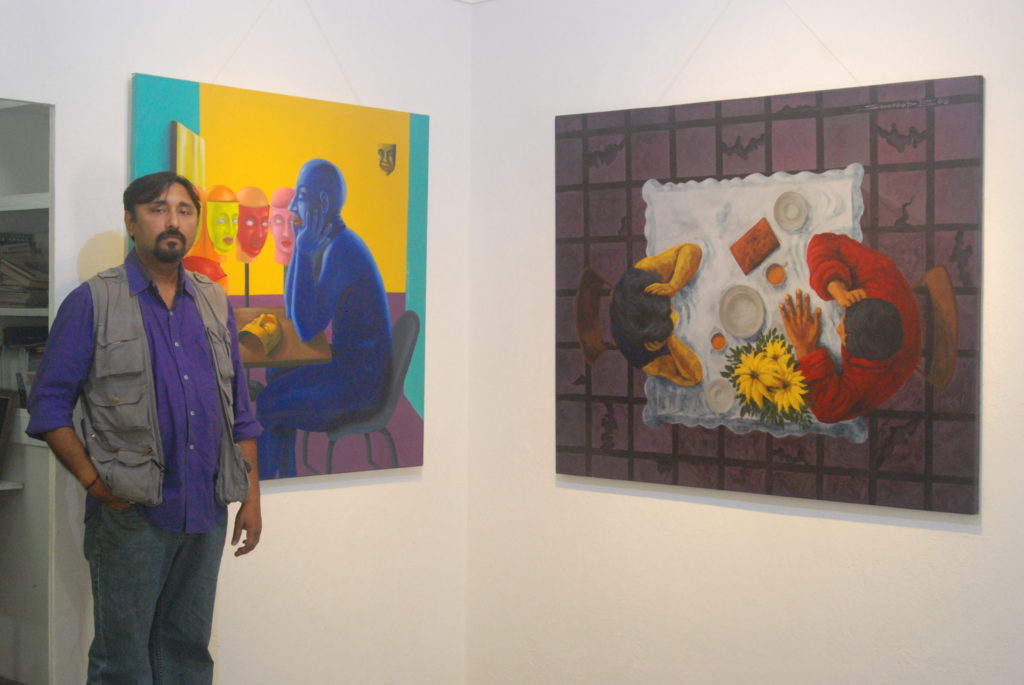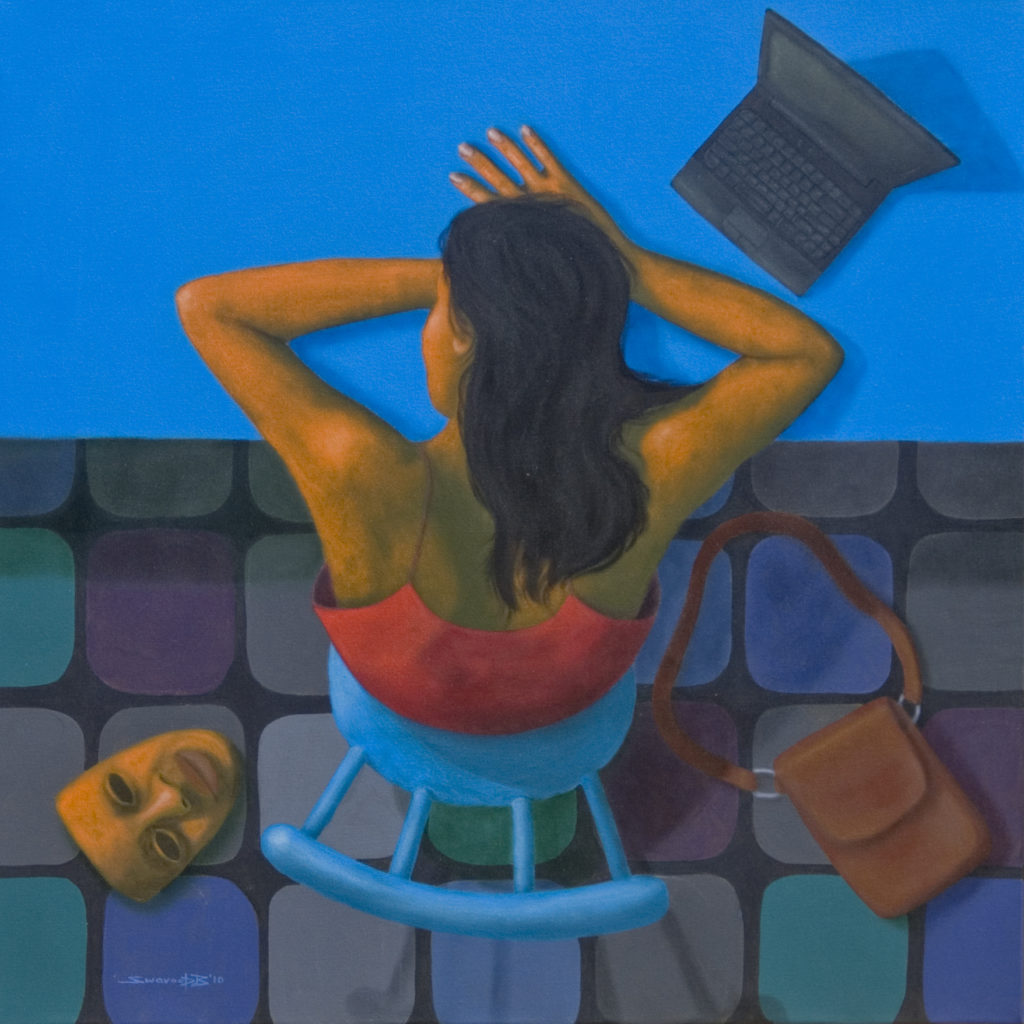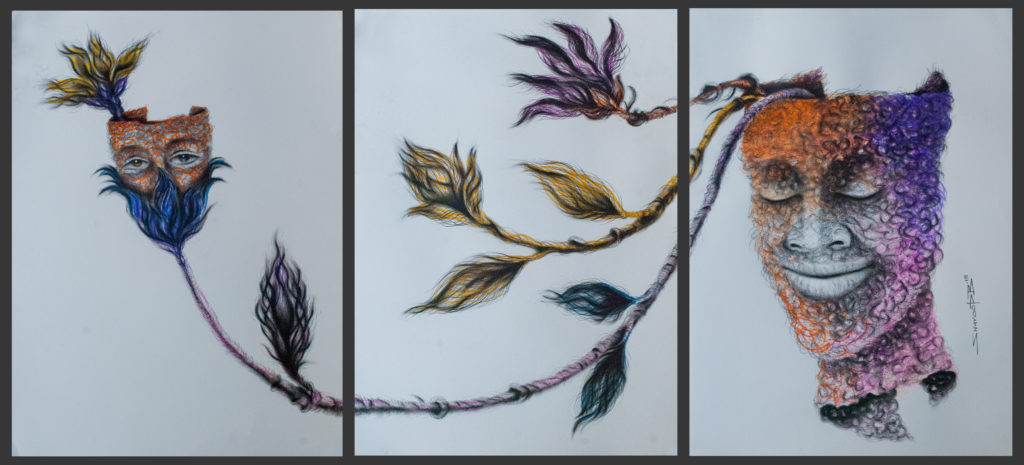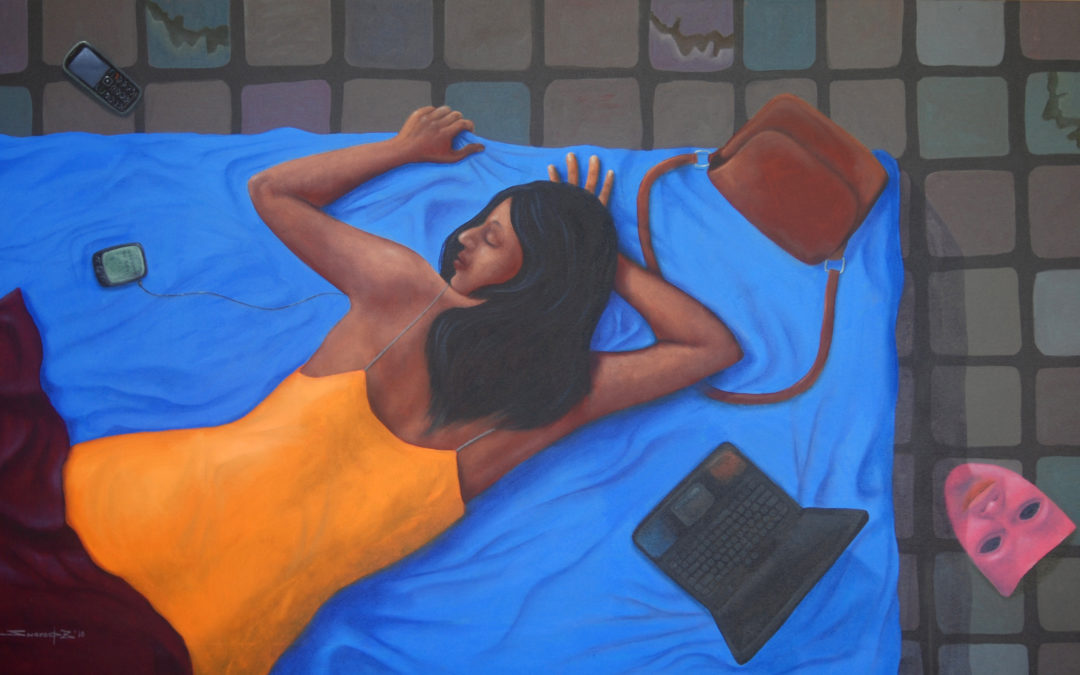Artist Swaroop Biswas started creating illustrations for advertisements in newspapers and other print publications when he was 13-14 years old. The journey to get into an art college started after board exams and by this time he was determined to be an artist, much to the disappointment of everyone around. “I remember reading a lot of comics while in school. I used to frequent a library where I could sit and read as it wasn’t appreciated at home. So comics were often hidden by me inside a book or a file. From there I found a medium of expression mostly in storytelling format. So much so that it became prime mode of expression. I remember, getting caught drawing a teacher’s face in class. All the back pages of my school writing books were full of drawings and became a complete canvas of expression. I remember once after being punished in school, I drew a gun and a caricature resembling my teacher. Got caught doing this and got punished again,” he reveals.

What is your artistic background?
I did apply for admission in the university to pursue science, but I just couldn’t put myself to go through it and went to Kolkata to take admission in Government College of Arts. I spent around 2 years in Kolkata at Indian Art College and then joined College of Arts and Crafts in Lucknow. Those years became the foundation for me to become an artist. After college I moved to Delhi which was another learning experience. The era of digital media was just starting and I learnt and experimented with the digital medium. Along with traditional mediums, digital media became a part of my thought and creative process too. I started working as a graphic designer at NIIT Ltd. I always had lots of interest and curiosity in human psychology. While my college time in Lucknow I studied visual and behavioural psychology. My art and design practice got hugely impacted by these learnings. My interest in experience design only strengthened my curiosity in psychology and my subjects and techniques kept changing as an impact.
What’s integral to the work of an artist?
As much I have come to learn and observe each artist has a different and unique practice. The art practice is very much aligned with the persona of the artist. The life events, exposure, experience, chemistry and relationship with people keep creating a unique practice for each artist. Mine is deeply rooted in my mind. I don’t dwell upon events, happenings, or larger world scenarios.
My subjects are around me and I never question or judge. Never give my opinion but choose to go on experiencing, learning and observing. That’s what my art practice revolves around. My expression comes through the protagonists in my works. People, objects, mostly humans and their psyche creates the ecosystem.

What role does artist have in society?
An artist thrives on expression. All genres of arts give a medium to society to express and even live and experience the art. The memories, life events, relationships, feelings all get aligned around different art genres of that time. A lot of artists align themselves with time and portray their expressions and impact of events, which becomes such an important treasure with time like Picasso’s Guernica.
What art do you most identify with?
I identify mostly with surreal art forms. Right from the beginning of my exposure to art, I had an inclination towards surreal art. Over a period of time I traveled a lot and got exposed to the work of artists like Salvatore Dali, Chagall, Duchamp, and Picasso through many museums. I read about them extensively too and my practice kept evolving with time. But I believe I still have surreal alignment in some ways of my visualization.

What themes do you pursue?
My practice is aligned with human experiences and behaviour. The time, experience, relativity, specific moments, how an entire lifetime gets defined by a few specific moments. The layered thinking in our minds. All of these culminate into human representation on varied surfaces or installations.
But human presence is a mainstay in my works. If not directly then through objects or some other symbols, but a must. I work with all commonly used mediums like charcoal, oil, acrylic, pastel and watercolour.
What’s your favourite art work?
- In search of lost self by Rene Magritte
- Burning Giraffe by Dali
- Beast by Ganesh Pyne
- Wound series by Somnathhore
- Man with the dark glasses by Sudarshan Shetty
- Some works by Anju Dodiya specifically how she uses black
- The surreal style of Liu Xia O dang
- Jung HoKwon, the way he uses skull as a central motif.

Describe a real life situation that inspired you?
During my travels I keep meeting people, while going to Yellowstone National park in a bus; I got to interact with the driver. He was a Caucasian. We figured so many cultural similarities between the social practices that he decided to visit India on his next break. He was a backpacker and had visited quite a few museums including Louvre. What an amazing interaction and learning experience this was.
While on a taxi ride in Salt Lake City, Utah, the driver happened to be a Nepalese. He was so excited to know that I have lived in Gorakhpur where he also lived during his childhood. The one hour journey was filled with discussions about places, memories, common places we had visited. By the end of the journey I had a friend. Learning about human behaviour, forming such basic human bonds, beyond language, geography, race and the ability to empathize seems to be the biggest gift I have been blessed with and I am so thankful for it.

What jobs have you done other than being an Artist?
I started working as an illustrator very early in life. While in college, I used to travel to Delhi to find part time jobs to keep up with the expenses of my college studies.
After college I started as a graphic designer with NIIT ltd’s learning software business unit. It was a huge learning experience for me as other than digital skills my watercolour art skills were leveraged extensively for animations. After moving to Mumbai in 1998, I started working with Arjun Mitra in his company Axis Interactive and after a journey with Zee interactive, Jasubhai Digital Media, Tata Interactive I started my own venture Redcup Interactive Designs in 2010. The company provided e learning, user experience, design solutions, art products and workshops. In 2014 I had to close down Redcup and move to Hyderabad to work with Think Design. Now I am working with Hexaware Technologies ltd. as Head of Experience Design.

Why Art?
For me art became a major mode of expression quite early in life. The act of drawing, illustrating, visualizing came naturally to me. I felt comfortable visualizing and drawing compared to writing or speaking. Over a period of time I learnt and researched psychology in various streams, learnt acting to create motive and the expanse kept on widening while subjects also evolved. But even after all learning, my subjects remained related to my immediate personal experiences. The more I learn, the more my practice of art became holistic, almost a round the clock thought process.
What is an artistic outlook on life?
Art is a very basic element of human existence. It’s omnipresent in everything we do. An evolved culture accentuates the practice and impact both. The exposure to traditions, history and generational passing on of the culture also plays a big role. All evolved societies had art as a central element to the social structure. Art in all it’s genres becomes a common thread to connect communities and groups. It’s a huge component of human civilization.

What memorable responses have you had to your work?
Sometimes expressions connect some common strings with viewers. While observing one of my paintings, {title: Burnt) viewers kept on sharing their experiences about how they saw their own life looking at the painting. They also shared their experiences and it was so magical how all of them interpreted it from their own point of views. It’s an overwhelming experience to connect with so many souls sharing emotions.
What food, drink, song inspires you?
The feeling of being away from one’s roots is a concurrent feeling. A song by Jagjit Singh ‘Ab mai rashan ki kataaron me nazar aata hoon’ resonates deeply with me. My car playlist is dominated by my daughter’s choice these days. So I am listening to Mazor Lazer, Selena Gomez, Tones & I, imagine Dragons and the kind. My travels expose me to various cuisines and I love experiencing all kind of cuisines. I specifically love all Asian cuisines. Food wise I am completely at home anywhere in the orient. Whenever in UK, I look for Afghani and Pakistani restaurants to run through their delicacies. Korea was a very rich gastronomic experience. In US I have experienced so many great options in traditional native Indian food, Mexican and South American palette. Even more so as food becomes a great bard and becomes a bridge to understand cultures and communities.

Is the artistic life lonely? What do you do to counteract it?
Mostly I have struggled to communicate during interpersonal interactions; though I have been a skilled communicator which is an irony. There’s always a gap on the psychological level. A lot is running in our minds which doesn’t show on the surface. I don’t know about all artists, but in our minds there is so much activity that it makes one isolated. It happens with me too. There is an entire world or worlds in our minds, stories, people, things, an entire universe, may seem lonely at times, yes, but only on the surface. There are entire lives being lived within our minds. It’s a content pull and push between the real world outside and the one within our minds. The glitz around art events does feel ironical to me. A practice so heavily seeped in philosophy and psychology gets wrapped in extremely elite materialism. But these ironies make life interesting. I quite like it actually.
What do you dislike about the art world?
When you say art world, you mean the art community, buyers, curators, gallerists, and the ecosystem. It’s like any other community or business. I don’t dislike anything in particular. I do feel art should be defined in genres like films or music. It will help a lot of skilled people earn a livelihood. A lot of artisans and craftsmen, develop great skills and are supremely gifted, but struggle to sell because of lack of sales acumen.

What do you dislike about your work?
Not about my work, but I just can’t seem to paint abstract. I love some abstract works done by other artists. I specially love some works of Somnath Hore and Akbar Padamsee. In fact I had the good fortune to be around both of them and I always managed to get scolded because of my unending curiosity and barrage of questions. I was always this wide eyed child very fortunate to be in company of the two masters of our era. But I could not ever attempt an abstract; I am hoping I will someday may be in the future.
What do you like about your work?
I love each moment of it. The entire process is so delightful. Sometimes I don’t even bother completing an art work. I live an entire cycle with a certain painting, outside my mind it might not manifest in a complete artwork but in mind I have already completed many variations of it. Played with it, seen it in dreams, felt it and then it seems complete, but in reality it remains incomplete. But I love this process before the work gets completed.

Should art be funded?
Yes. Art is one of the basic paradigms of human nature. Not for the commerce of art, but art must be either directly funded or should be created in to a self sustained ecosystem. Art is not just the famous and known names. It’s a part of life from adolescence to death. It must be taught as a common subject across educational streams and funded for it’s humane aspect. Our lives should be surrounded by art and expression. Expression leads to discovery and discovery brings change and new experiences.
What is your dream project?
I constantly dream of doing large scale installations. I have done a few, but it takes a lot of investment, so I keep dreaming about large scale public art. I keep visualizing that.

Name three artists you would like to get compared to.
- Salvator Dali
- Ganesh Pyne
- Damien Hirst
Favourite or most inspirational place?
My studio and my mind.
What’s the best piece of advice you have been given?
I was once told to detach myself once I complete a work. This advice has stayed with me over the years and is etched in my mind.
Professionally what’s your goal?
I don’t have a specific professional goal. But I do want to travel extensively, work with people, show my works, and experience this earth to the fullest.
Future plans?
To create more public art, more installations, more paintings and participate in more shows.










Great to Something Touching our Heart …..!!!